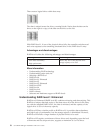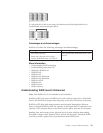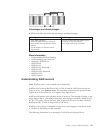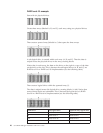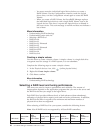
If you use a RAID level-5E logical drive in a failover or cluster configuration, the
RAID level-5E logical drive will not failover while undergoing compression or
decompression.
Advantages and disadvantages
RAID level-5E offers the following advantages and disadvantages.
Advantages Disadvantages
v 100% data protection
v Offers more physical drive storage
capacity than RAID level-1 or level-1E
v Higher performance than RAID level-5
v Lower performance than RAID level-1
and level-1E
v Supports only one logical drive per array
v Cannot share a hot-spare drive with other
arrays
v Not supported on all controllers
More information
v Understanding RAID technology
v Understanding stripe-unit size
v Selecting a RAID level
v RAID level-0
v RAID level-1
v RAID level-1 Enhanced
v RAID level-5
v RAID level-5EE
v RAID level-6
v RAID level-x0
v RAID volumes
Understanding RAID level-5EE
Note: This feature is not supported on all controllers.
RAID level-5EE is similar to RAID level-5E but with a more efficient distributed
spare and faster rebuild times. Like RAID level-5E, this RAID level stripes data
and parity across all of the drives in the array.
RAID level-5EE offers both data protection and increased throughput. When an
array is assigned RAID level-5EE, the capacity of the logical drive is reduced by
the capacity of two physical drives in the array: one for parity and one for the
spare.
The spare drive is part of the RAID level-5EE array. However, unlike RAID
level-5E, which uses contiguous free space for the spare, a RAID level-5EE spare is
interleaved with the parity blocks, as shown in the following example. This allows
Chapter 3. Using ServeRAID Manager 41






